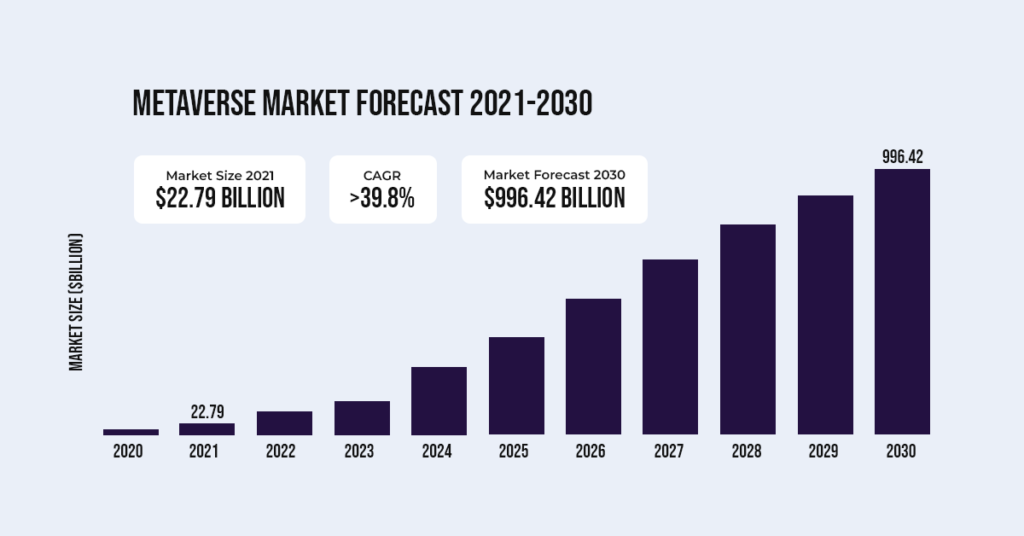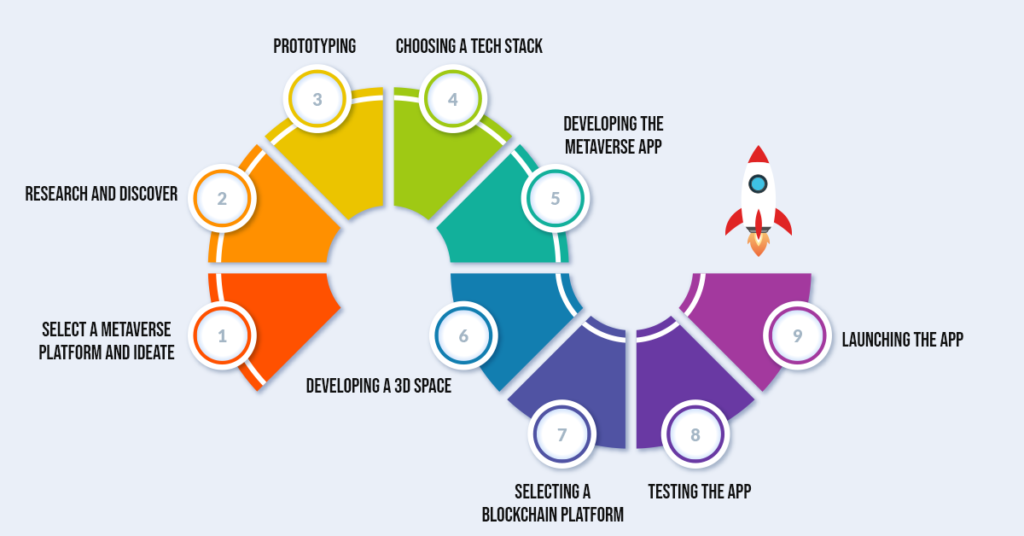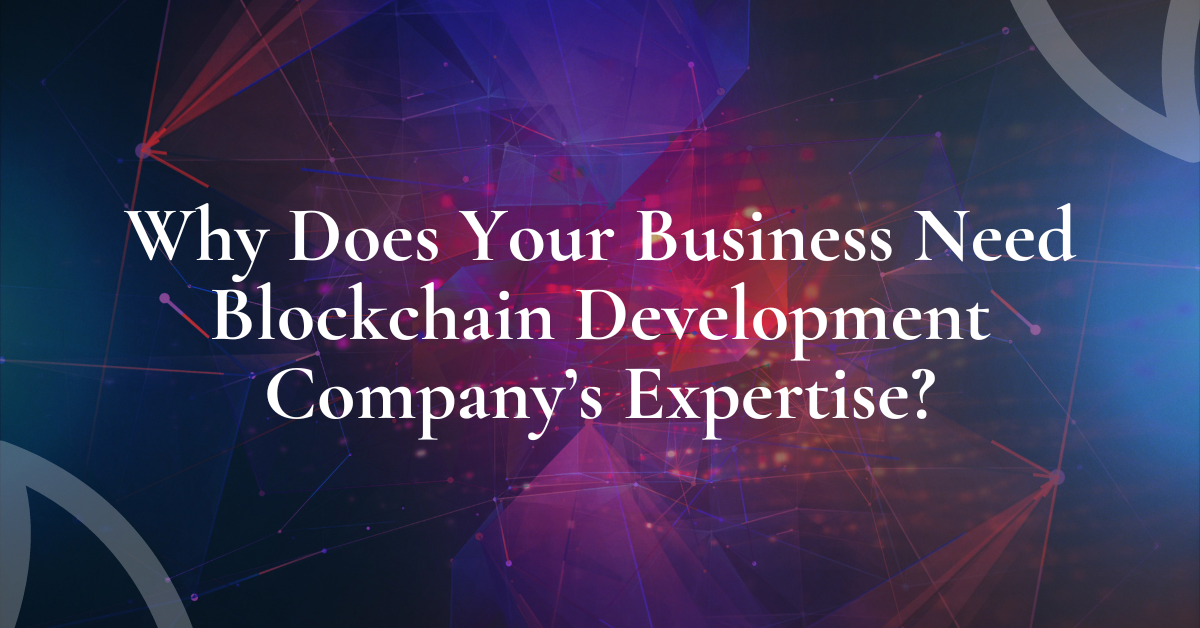
How to Develop a Metaverse App in 2024?
-
By Amardeep Singh Sandhu
-
1st February 2024
Throwback to the time when Meta, formerly known as Facebook, introduced the immersive world of ‘Metaverse’ in the latter half of 2021. Since then, the Metaverse world has been an emerging reality. Later, in 2023, Apple announced rolling out ‘Apple Vision Pro,’ an elite version of Metaverse. All these events contribute to the staggering growth of Metaverse in today’s fast-paced digital world.
Companies in the early stages of Metaverse app development are more likely to become market winners in the upcoming 5 to 10 years.
– The Economic Times
One of the most innovative ways to parse into the Metaverse industry is by building/investing in your own Metaverse app. The Metaverse industry is projected to grow at a CAGR of 36.80% by 2030, thus reaching a market size of $900 billion.

This blog is a valuable source of information for individuals/companies who wish to enter the global market of Metaverse in 2024. We’ll discuss what Metaverse is, how to build a Metaverse app, the technologies that make up the Metaverse, and the challenges involved in Metaverse app development in 2024.
Without further ado, let’s delve into the realm of pure knowledge!
What is Metaverse?
Many people think that putting on a Virtual Reality (VR) headset and experiencing a virtual world is what Metaverse is. However, it is just one facet of the term ‘Metaverse.’ It is much more than that.
Metaverse is an aggregation of multiple virtual realities that exist beyond video games and after removing VR headsets. It is a spatial computation technology that combines different virtual realms. You can virtually meet friends over Metaverse, attend a concert, or meeting, host a party, make transactions, and even buy a piece of land in Metaverse! For example, Fortnite gives users an immersive game experience through near-reality games and socializing. It lets you create your character, play games, make friends, and socialize. Therefore, it is a perfect example of Metaverse.

The game came out in 2017 by Epic Games and offers an immersive, real-life digital experience. Apart from games, there are many other examples of Metaverse, such as Sandbox, where users can share, build and monetize creations using Ethereum.
Steps Involved in Building a Metaverse App
It is indeed a task of intricacy and iterations of development and testing when it comes to Metaverse app development. We made it easy for you to build a metaverse app from scratch. Follow the steps mentioned below:

- Select a Metaverse platform and ideate
The first step to building a Metaverse app is to choose the Metaverse platform of your choice. It is also based on the kind of app you wish to develop. You can select an app from many options, such as real estate, 3D gaming, digital shopping stores, social apps, etc.
- Research and discover
The next step is to perform comprehensive market research to understand the user requirements and market trends. You can then create a prototype based on the research you do. Conducting an in-depth analysis of competitors is also imperative for a successful Metaverse app development in 2024.
- Prototyping
The next step is to start designing your Metaverse app. The process involves generating a 3D virtual environment of your app, creating interaction points and developing a user-friendly experience. You must ensure that the app conveys a story. This enhances user experience. Feel free to incorporate AR/VR technologies for an immersive experience.
- Choosing a tech stack
After designing your Metaverse’s virtual environment, it is imperative to choose a Metaverse tech stack that the developers need to bring the app to life. Based on the use cases and the requirements of the app, you can choose any one of the below-mentioned tech stacks:
- Backend development for Blockchain: Java, Python, Node JS, DocumentDB, React Native
- Frontend development for Blockchain: React, Angular, Vue JS, HTML, CSS, React Native
- 3D modeling software: Unreal Engine, Unity, CRYENGINE
- AI development tools: TensorFlow, Scikit-Learn, AWS sage maker
- Mobile development: Swift (iOS), Kotlin (Android), React Native (cross-platform dev)
- Database: MySQL, PostgreSQL, Oracle Database
- Cloud infrastructure for scalability: Amazon Web Services (AWS), Microsoft Azure, Google Cloud
- AR/VR tools: Unity, Unreal Engine, Google ARCore, Apple ARkit, Maxst AR
- IoT: AMQP, Azure IoT Hub, MQTT, Lorawan
5. Developing the Metaverse app
After selecting the right tech stack, you can take it to the development stage. This stage involves developing the app, which includes adding a suitable set of interactive elements, features and other social tools.
On the other hand, if you’re hiring a developer, ensure you engage both a JavaScript and Blockchain developer. Hiring UI/UX developers for an aesthetically pleasing user experience is also crucial.
6. Developing a 3D space
It is essential to develop a 3D space for the Metaverse app to function. This is when you’ll need some tools to design the 3D architecture. You may use software like Unity 3D, Unreal Engine, etc.
7. Selecting a blockchain platform
The next step is to choose a blockchain platform that suits your Metaverse app development requirements. Various factors can influence the selection of a blockchain platform that caters to your needs. For instance, if you’re building a 3D real estate Metaverse app, the goal should be to choose a high transaction speed, low-cost blockchain platform such as Tron. It is perfect for decentralized finance (DeFi) and decentralized apps (dApps).
8. Testing the app
It is essential to test your Metaverse app before making it live for the audience. You must follow an iterative cycle of testing. This process must involve resolving speed issues, debugging base codes, fixing performance glitches, etc.
9. Launching the app
You can then launch the app, promote it, and spread it to a broader audience base. Remember to keep on looking for bugs in your app. Rolling out new updates and bug fixes in the app is critical.
Technologies that Makeup Metaverse Apps
Different technologies are required to build a Metaverse app. The technologies needed for an up-and-running Metaverse app are mentioned as follows:
1. Virtual and Augmented Reality (VR/AR)
Virtual Reality (VR) and Augmented Reality (AR) form the core of Metaverse. You can experience virtual online shopping, virtual meetings with colleagues, and more. Experience the magic of VR through a VR device such as Apple Vision Pro.

Augmented Reality (AR) supplements reality with virtually-created elements. It scans a real-life frame through a camera and then adds features. It is a revolutionary technology in itself.
The above image is a perfect example of the application of Augmented Reality. You can scan a spot in your home through a device’s camera to see how furniture looks even before you buy it. You can conceptualize the process of Metaverse app development around it!
2. Blockchain
Blockchain technology is a novel and vital technological aspect of Metaverse. A user can make safe and secure transactions because of the blockchain technology applied in the Metaverse realm.
The highlighting feature of the blockchain technology is decentralization. Harnessing its power can fuel the Metaverse to great heights. Blockchain has enabled the monetization of digital assets such as NFTs, digital arts, etc. It is an essential part of the Metaverse since it pushes decentralized assets.
3. Internet of Things (IoT)
Internet of Things (IoT) is a groundbreaking technology that aids the Metaverse in virtually replicating real-life objects on the spot. It helps the Metaverse comprehend an object and generate a virtual copy of it in the virtual world of the Metaverse.
4. Artificial Intelligence (AI)
Artificial Intelligence is another vital technology that plays a significant role in Metaverse. Because of AI, the Metaverse can create 3D avatars of characters in the game world. It is also a breakthrough technology in developing Chatbots. These Chatbots help the users navigate through Metaverse, resolve issues, and cater to the user’s needs.
Artificial Intelligence (AI) uses other technologies, such as Natural Language Processing (NLP), Machine Learning, Voice/Speech Translation, and Computer Vision, to improve human-metaverse interaction.
5. Edge Computing
The latency rate plays a humongous role in enhancing a game’s experience. However, high latency rates can hamper the quality of the digital experience. This is why relying on cloud computing for efficient transactions or any other digital scenario is not a productive idea.
Edge computing performs real-time data analysis by eliminating the need to transfer data to the cloud or data centers. It conducts research in proximity to the source for low-latency experiences. Since the number of Metaverse users will only rise, integrating edge computing with Metaverse is the cherry on top!
Challenges involved in Metaverse app development in 2024

The Metaverse technology is still an emerging one. Therefore, some security-related, identity-related, and other bothersome concerns are attached to it. Some of the prominent challenges involved in using the Metaverse are as follows:
- Prone to security breaches
Metaverse is vulnerable to identity thefts and security breaches. Any individual or a bot can become an imposter and pretend to be someone else. This can lead to increased malicious activities on Metaverse, thus leading to identity theft and sensitive data breaches.
This is why having solid and robust security systems on Metaverse apps is essential.
- Inappropriate content
Since there are no content regulations or checkpoint systems to override inappropriate content, some individuals can take advantage of it. This can cause a potential problem for other users in the Metaverse virtual environments.
- Privacy issues
The Metaverse apps collect real-time information about the users to enhance user experience, targeting the audience better and optimizing the app interface. This raises a potential privacy concern for the users, who might withdraw from using the app.
- Limited devices
It is daunting to curate an equally immersive experience of Metaverse apps for users on various devices such as smartphones, laptops, VRs and desktops. One can only experience an immersive experience when accessing Metaverse through VR headsets.
- Limited accessibility
Only some people are familiar with the functionality of Metaverse digital assets such as blockchain, NFTs, and cryptocurrencies such as Ethereum, Dogecoin, Bitcoin, etc., which reduces the utility of Metaverse environments across different audience segments.
How to Combat Metaverse App Development Challenges?
With new technologies come new challenges. It is crucial to withstand Metaverse development challenges to succeed in the Metaverse development space. Building a Metaverse app is a work of intricacy, experience and technical prodigy. This is why outsourcing the app development process is an informed decision.
Deftsoft is an industry-leading Metaverse app development service-based company with over 17 years of established business in the country. We have a massive team of experienced blockchain developers, mobile app developers, UI/UX designers and Metaverse developers who can bring your vision to life. With novel technologies and approaches, we offer hassle-free Metaverse app development services.
Feel free to reach out to us. We’re here to serve the best!
Final Thoughts
The Metaverse industry is one of the most daunting yet exciting spaces. It amalgamates varied new-age technologies such as blockchain, AR/VR, Artificial Intelligence (AI), Machine Learning (ML), edge computing, 5G, and more. Creating a Metaverse app stands out only when professionals with experienced hands do it.
It is the best practice to hire an experienced team of blockchain and Metaverse developers to bring your vision to life. In the upcoming years, Metaverse will be far-fetched and much more than a virtual space for gaming and socializing.
Recent Articles
-

Unity vs Unreal Engine 5: Which is Better?
-

Non-Negotiable Tips for Developing a P2P Lending Platform
-

The 8 Leading Cross-Platform App Development Frameworks You Should Know
-

Step-by-Step Guide: How to Build a dApp on Ethereum with Ease
-

Why Does Your Business Need Blockchain Development Company’s Expertise?

Amardeep Singh Sandhu
 1st February 2024
1st February 2024